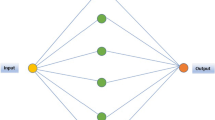Abstract
In this article, a simple and efficient approach for the approximate solution of a nonlinear differential equation known as Troesch’s problem is proposed. In this article, a mathematical model of the Troesch’s problem is described which arises in confinement of plasma column by radiation pressure. An artificial neural network (ANN) technique with gradient descent and particle swarm optimization is used to obtain the numerical solution of the Troesch’s problem. This method overcomes the difficulty arising in the solution of Troesch’s problem in the literature for eigenvalues of higher magnitude. The results obtained by the ANN method have been compared with the analytical solutions as well as with some other existing numerical techniques. It is observed that our results are more approximate and solution is provided on continuous finite time interval unlike the other numerical techniques. The main advantage of the proposed approach is that once the network is trained, it allows evaluating the solution at any required number of points for higher magnitude of eigenvalues with less computing time and memory.




Similar content being viewed by others
References
Weibel ES (1958) Confinement of a plasma column by radiation pressure. In: Landshoff RKM (ed) The plasma in a magnetic field. Stanford University Press, Stanford, pp 60–76
Roberts SM, Shipmann J (1976) On the closed form solution of Troesch’s problem. J Comput Phys 21(3):291–304
Scott MR (1975) On the conversion of boundary value problems into stable initial value problems via several invariant imbedding algorithms. In: Aziz AK (ed) Numerical solutions of boundary value problems for ordinary differential equations. Academic Press, New York, pp 89–146
Khuri SA (2003) A numerical algorithm for solving the Troesch’s problem. Int J Comput Math 80(4):493–498
Feng X, Mei L, He G (2007) An efficient algorithm for solving Troesch’s problem. Appl Math Comput 189(1):500–507
Chang SH, Chang IL (2008) A new algorithm for calculating the one dimensional differential transform of non linear functions. Appl Math Comput 195(2):799–808
Chang SH (2010) A variational iteration method for solving Troesch’s problem. J Comput Appl Math 234(10):3043–3047
Chang SH (2010) Numerical solution of Troesch’s problem by simple shooting method. Appl Math Comput 216(11):3303–3306
Zarebnia M, Sajjadian M (2012) The sinc-Galerkin method for solving Troesch’s problem. Math Comput Model 56(9–10):218–228
Vazquez-Leal H, Khan Y, Fernandez-Anaya G et al (2012) A general solution for Troesch’s problem. Math Probl Eng, Article ID 208375
Khuri SA, Sayfy A (2011) Troesch’s problem: a B-spline collocation approach. Math Comput Model 54(9–10):1907–1918
Shirvany Y, Hayati M, Moradian R (2008) Numerical solution of the nonlinear Schrodinger equation by feedforward neural networks. Commun Nonlinear Sci Numer Simul 13(10):2132–2145
Kennedy J, Mendes R (1995) Particle swarm optimization. Proc IEEE Int Conf Neural Netw 4:1942–1948
Mendes R, Cortez P, Rocha M, Neves J (2002) Particle swarms for feed forward neural network training. Proc Int Jt Conf Neural Netw 2:1895–1899
Yadav A, Deep K (2013) Shrinking hypersphere based trajectory of particles in PSO. Appl Math Comput 220(1):246–267
Khan JA, Zahoor RMA, Qureshi IM (2009) Swarm intelligence for the problems of non-linear ordinary differential equations and its application to well known Wessinger’s equation. Eur J Sci Res 34(4):514–525
Jordehi AR (2014) Particle swarm optimization for dynamic optimization problems: a review. Neural Comput Appl 25(7–8):1507–1516
Jhang JR, Zhang J, Lok TM, Lyu MR (2007) A hybrid particle swarm optimization-back propagation algorithm for feed forward neural network training. Appl Math Comput 185(2):1026–1037
Tsoulos IG, Gavrilis D, Glavas E (2009) Solving differential equations with constructed neural networks. Neurocomputing 72(10–12):2385–2391
Clerc M, Kennedy J (2002) The particle swarm-explosion, stability and convergence in a multidimensional complex space. IEEE Trans Evol Comput 6(1):58–73
Pedersen MEH, Chipperfield AJ (2010) Simplifying particle swarm optimization. Appl Soft Comput 10(2):618–628
Troesch BA (1976) A simple approach to a sensitive two-point boundary value problem. J Comput Phys 21(3):279–290
Lagaris IE, Likas A (1998) Artificial neural networks for solving ordinary and partial differential equations. IEEE Trans Neural Networks 9(5):987–1000
Malek A, Shekari Beidokhti R (2006) Numerical solution for high order differential equations using a hybrid neural network—optimization method. Appl Math Comput 183(1):260–271
McFall KS, Mahan JR (2009) Artificial neural network method for solution of boundary value problems with exact satisfaction of arbitrary boundary conditions. IEEE Trans Neural Networks 20(8):1221–1233
Kumar M, Yadav N (2011) Multilayer perceptrons and radial basis function neural network methods for the solution of differential equations: a survey. Comput Math Appl 62(10):3796–3811
Lagaris IE, Likas A, Papageorgiou DG (2000) Neural network methods for boundary value problems with irregular boundaries. IEEE Trans Neural Netw 11(5):1041–1049
Mcfall KS (2013) Automated design parameter selection for neural networks solving coupled partial differential equations with discontinuities. J Frankl Inst 350(2):300–317
Acknowledgments
This work was supported by National Research Foundation of Korea (NRF) Grant funded by the Korean government (MSIP) (NRF-2013R1A2A1A01013886) and the Brain Korea 21 (BK-21) fellowship from the Ministry of Education of Korea.
Author information
Authors and Affiliations
Corresponding author
Rights and permissions
About this article
Cite this article
Yadav, N., Yadav, A., Kumar, M. et al. An efficient algorithm based on artificial neural networks and particle swarm optimization for solution of nonlinear Troesch’s problem. Neural Comput & Applic 28, 171–178 (2017). https://doi.org/10.1007/s00521-015-2046-1
Received:
Accepted:
Published:
Issue Date:
DOI: https://doi.org/10.1007/s00521-015-2046-1




